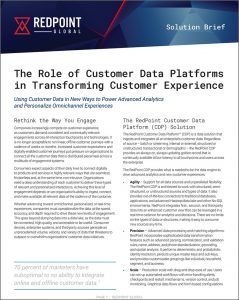 Reassessing any part of the MarTech stack is always a game of risk vs. reward. This holds true really for any enterprise technology, but it seems the burden weighs particularly heavy on the shoulders of marketers and the CMO. The acute need to create a personalized customer experience demands a modern, integrated customer engagement platform. This fact may take marketers outside their comfort zone as far as technology limitations they might otherwise countenance.
Reassessing any part of the MarTech stack is always a game of risk vs. reward. This holds true really for any enterprise technology, but it seems the burden weighs particularly heavy on the shoulders of marketers and the CMO. The acute need to create a personalized customer experience demands a modern, integrated customer engagement platform. This fact may take marketers outside their comfort zone as far as technology limitations they might otherwise countenance.
Seen in this light, an honest reassessment will accept more of the common risks of upheaval associated with people, processes, and technology change. This is particularly true if the end result is to build and deploy a unified view of the customer that will empower marketing to deliver personalization, real-time customer interactions, and next-best actions across an omnichannel customer journey.
The power of a unified view – a persistently updated golden record that provides a 360-degree customer view – should erase any doubt whether an existing platform that fails to deliver the capability is worthy of replacement. Consider the 2019 BRP Unified Commerce Study, where 87 percent of consumers surveyed said that it is important to receive “a personalized and consistent experience across channels.” Or a 2019 Merkle report where two-thirds (66 percent) of consumers surveyed rated customer experience over price when it came to making a purchase decision.
Benefits and Opportunity Tilt the Scale
A recognition that delivering a personalized customer experience drives revenue should make some of the inherent uncertainty around a new software implementation more palatable, particularly if a solution being replaced is graded against the new possibilities.
With typical nagging doubts out of the way, the primary organizing principle during a reassessment must be an ironclad understanding of specific goals and expectations. If the objective is, as outlined here, to possess a single customer view in the form of a golden record, marketing must have a defined use case in mind. The question, then, becomes less about the short-term effect of the transition and more about assessing which customer data platform (CDP) is right for the business.
Infrastructure change becomes another important factor because of a CDP’s role as the centerpiece of an engagement platform. We’ve outlined previously the five core requirements a CDP must include, which including ingesting data from all sources. Satisfying these requirements involves a host of secondary considerations when weighing potential risks – because of the CDP’s reach and potential to transform marketing operations. By ingesting data from all sources, a CDP provides enormous ancillary benefits having to do with better flexibility and scalability – as well as enterprise attributes to include performance, security, and privacy.
In that regard, an assessment should weigh whether a change will set the MarTech stack up for much easier changes and enhancements in the future. A CDP that fulfills the five core requirements, in other words, doesn’t just set marketing up with operational flexibility in delivering a superior customer experience, it also future-proofs the business.
By ingesting customer data from all sources, the right CDP renders complicated multi-wave integrations obsolete and minimizes frustrations of bringing people and processes up to speed with every new implementation. Think of a CDP with an open garden architecture as the hub of a spoked wheel; new components shouldn’t create people, process, and technology uncertainties when the “hub” is done right. The architecture provides a single point of operational control over data, decisions, and interactions – regardless of the designated use case. When business objectives change, the bespoked configuration abstracts the day-to-day user from complexity while maintaining the single point of control.
Making a Good First Impression
Of course, a full ex post facto ROI accounting will determine the accuracy of a risk vs. reward calculation, which makes it especially important to mitigate as much risk beforehand as possible by securing more than just vendor assurances when selecting a CDP.
When performance metrics are determined up front, it will be revealed very quickly post-implementation whether a CDP is delivering on its promises. Those metrics might relate to real-time performance, or whether advanced identity resolution is really bringing together online and offline facets of the customer record to create a true and accurate 360-degree view. Or those metrics might be more directly related to integration – whether the CDP delivers on a promise of open garden connectivity that truly delivers a single point of control.
And if the CDP falls short of expectations, the delivery of a personalized customer experience is too important to either wait for things to improve, point fingers, or – worst of all – ignore what’s happening. When 63 percent of consumers say that a personalized experience is a standard service they expect (according to a Harris Poll survey commissioned by Redpoint), it’s far better to cut bait early than late. If you’ve already made the determination that your existing MarTech stack falls short in transforming customer engagement, know that there is a CDP out there that is worth the short-term risks.
RELATED CONTENT
A CDP Implementation Guide: What You Need to Know
How Does Your CDP Stack Up? The Real-Time Difference
Key Questions to Ask When Evaluating an Enterprise CDP
Be in-the-know with all the latest customer engagement, data management, and Redpoint Global news by following us on LinkedIn, Twitter, and Facebook.

